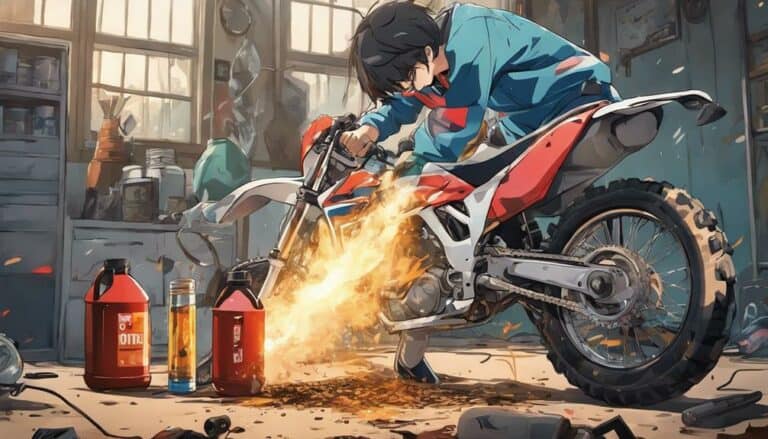Have you ever wondered if the type of oil you mix with gas in your 97 RT100 dirt bike can impact its performance greatly?
Well, the truth is, selecting the right oil and mixing it correctly is important for your bike's engine health.
But what exactly should you mix the oil and gas to for best results on your dirt bike?
Let's explore the importance of this process and reveal some essential tips to help you achieve the perfect fuel mixture for a smooth ride.
Key Takeaways
- Maintain a 32:1 gasoline to oil ratio for optimal performance.
- Use high-quality 2-stroke oil recommended by Yamaha.
- Accurate mixing prevents engine damage and ensures longevity.
- Avoid common mistakes by using a premix calculator and precise measurements.
Proper Oil-to-Gas Ratio
To achieve top performance and engine longevity for your 1997 Yamaha RT100 dirt bike, it's important to maintain a precise oil-to-gas ratio of 32 parts gasoline to 1 part oil as recommended by the manufacturer. This ratio is critical for the proper lubrication and functioning of the two-stroke engine in your dirt bike. Deviating from this recommended ratio can lead to engine damage, decreased performance, and potential seizing of the engine components.
By adhering to the 32:1 ratio, you guarantee that the engine receives adequate lubrication while also preventing carbon buildup and spark plug fouling.
Calculating and mixing the oil and gas in the correct proportions is essential for the overall health of your dirt bike's engine. Utilizing tools like a premix calculator or ratio cup can simplify this process and help you achieve the precise ratio required. Remember to always mix the oil and gas in a separate fuel can and shake thoroughly before pouring into the bike's tank to guarantee even distribution and prime engine protection.
Importance of Mixing Correctly
Mixing the oil and gas correctly is pivotal for ensuring peak lubrication and performance of your 97 RT100 dirt bike's engine. The precise oil-to-gas ratio recommended by the manufacturer, like the typical 32:1 ratio, plays a vital role in maintaining lubrication efficiency and overall engine performance.
Failure to adhere to this ratio could result in severe engine damage, such as piston seizure or increased wear, ultimately impacting engine longevity and performance. Consistency in following the specified mixing guidelines outlined in the owner's manual is essential for preventing costly repairs and ensuring proper maintenance of your bike.
Recommended Oil Types
For best performance and engine longevity on your 97 RT100 dirt bike, selecting the right oil type is essential. Yamaha recommends using Yamalube 2-stroke oil, but reputable brands like Motul, Bel-Ray, or Maxima are also compatible choices. When deciding between synthetic and conventional oils, opt for high-quality synthetic or semi-synthetic options for improved engine performance. These oils offer better lubrication, heat resistance, and overall protection compared to conventional oils. Make sure you follow the manufacturer's guidelines regarding oil viscosity and quality to maintain your bike's best functioning.
When mixing oil and gas for your 97 RT100, always adhere to the recommended ratios provided by the manufacturer. Proper mixing techniques are important to make sure the engine receives adequate lubrication and protection. Regularly checking and maintaining the correct oil levels will contribute to the longevity of your bike's engine. By choosing the right oil type and following the correct mixing procedures, you can uphold the performance and durability of your 97 RT100 dirt bike.
Tips for Mixing Oil and Gas
Consider utilizing a premix calculator to accurately determine the required amount of oil for the gas mixture in your 1997 RT100 dirt bike. Mixing techniques and measuring accurately are essential for maintaining your bike's engine performance. Here are some tips to guarantee the proper mixing of oil and gas:
| Mixing Technique | Measuring Accurately | Storage Considerations |
|---|---|---|
| Stirring thoroughly | Use a measuring cup | Store oil and gas separately |
| Shake vigorously | Follow the ratio | Seal containers properly |
| Use a dedicated can | Double-check amounts | Keep in a cool, dry place |
To avoid contamination, always store oil and gas separately and seal the containers properly. This practice not only prevents unwanted substances from entering the mixture but also maintains fuel efficiency and engine performance. By measuring accurately and following the recommended gas-to-oil ratio of 32:1, you can ensure the ideal lubrication and functioning of your dirt bike's engine.
Avoiding Common Mistakes
To ensure peak engine performance and longevity for your 97 RT100 dirt bike, adhering to the manufacturer's recommended gas-to-oil ratio is crucial in avoiding common mistakes.
Preventing damage to your engine begins with ensuring you mix the oil and gas accurately within the prescribed ratio. Using either too much or too little oil can result in issues like fouled spark plugs, excessive smoke, or even engine overheating, ultimately affecting the bike's performance and lifespan.
To prevent errors, refrain from eyeballing the oil mixture; instead, use a measuring cup or ratio cup for precise measurements. Ensuring accuracy in your fuel mixture not only prevents potential damage but also maintains ideal engine function.
Regularly checking and adjusting the oil and gas ratio will help you keep your 97 RT100 running smoothly and efficiently, enabling you to enjoy your rides without unnecessary interruptions.
Conclusion
To sum up, ensuring the proper oil-to-gas ratio in your 97 RT100 dirt bike is essential for peak performance. Just like how each component in your bike must work together seamlessly, the right fuel mixture is the key to a smooth and trouble-free ride.
By carefully measuring and mixing the oil and gas, you symbolize the precision and attention to detail needed to keep your bike running smoothly. Ride on with confidence knowing you've taken the necessary steps for optimal performance.

